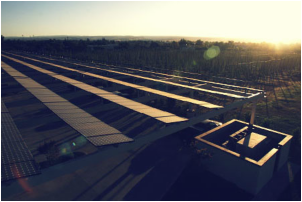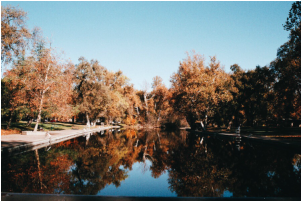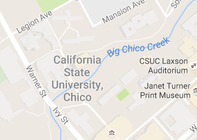Adaptation |
With climate change, there is a significant but predictable delay between cause (CO2 emitted) and effect (temperature increase.) The greenhouse gasses that will affect Chico in 2030 have already been emitted; we can project the rise in temperatures with a high degree of certainty. Chico must respond now by preparing for the impacts predicted to come within the next fifteen years. Here are some possible adaptive actions.
|
Temperature
We have identified several adaptive actions the City could pursue in response to an increase in temperatures due to climate change. Higher summer temperatures and extreme heat events will place vulnerable populations at risk for heat-related illnesses. In response, the City could identify “certified cooling centers” — places where individuals can cool off during the hottest parts of the day— that are advertised around town for public use. Government buildings, such as libraries, could have back-up generators to ensure the cooling centers stay functional even in heat-related power outages. Medical centers also need to prepare for an influx of patients that will be admitted during extreme heat events. The City could encourage the owners of commercial buildings to paint the roof of their building white to reflect the heat and reduce the demand on the electrical grid for air conditioning. Higher temperatures will peak in the late afternoon. The City could bargain to adjust the schedule for City employees who work outdoors, starting earlier to avoid the hottest part of the day. At the extreme temperatures predicted, asphalt will begin to degrade and become more soluble. Participating in statewide road trials provides an opportunity to update the roads with new materials designed to withstand the heat to come. |
|
WILDFIRE
We have identified several adaptive actions the City could pursue in response to the increased threat of wildfire due to climate change. To start, the City could increase public education about fire safety, as humans start 90% of all fires. The City could undertake an annual education effort targeted at residents along the urban/wildlife interface that would teach homeowners how to decrease their own fire risk. Another action is to implement an aggressive vegetation management plan (VMP) in areas of thick drought-stressed vegetation, such as Bidwell Park. The City could also pursue further fire risk reduction in vulnerable areas on the eastside of town through zoning and other land use measures. Finally, the City should maintain the current level of fire suppression through increased staffing during the fire season. The City could explore new technology, as well as further interagency cooperation, to offset increased demands associated with these actions. |
|
SNOWPACK
We have identified several adaptive actions the City could pursue in response to a decrease in snowpack due to climate change. Warmer storms in the winter will drop more precipitation as rain instead of snow. To accommodate the heavy rainfall and prevent the spread of pollutants, all sidewalks, parking lots, and large-scale landscaping could install water recharge zones in the form of rain gardens, bioswales, and pervious surfaces. Recharge zones allow water to percolate down into the ground, keeping it out of the storm drains. Still, heavy rain will overwhelm the storm drain system, especially in the older neighborhoods in town. Installing high-capacity storm drains in key areas and maintaining the vegetation in the four major waterways will be crucial adaptations to the risk of localized flooding. In the summer, more frequent droughts will place increased demands on irrigation for public landscapes. In response, the City of Chico could install tertiary-level treatment at the Waste Water Treatment Plant, along with the piping infrastructure to bring treated water back to Chico to water Bidwell Park and other public landscapes. |
Mitigation |
The “climate lag” between cause and effect is as short as twenty years, meaning the greenhouse gasses affecting Chico in 2050 have yet to be released. It is still possible to prevent the worst effects of climate change by doing our part to mitigate world emissions. Fortunately, the City has a plan for reducing community greenhouse gas production. There are also many things that businesses and individuals can do to reduce emissions. Here are some possible mitigation actions.
Dispatches from the Future
-
Friday Night Concert, 2035
-
CSU, Chico Graduation, 2037
-
City Council Annual Budget Meeting, 2040
-
Johnny Appleseed Days, 2048
<
>
|
75th Anniversary
It is the fourth day of heat wave, the first of the summer. It has been over 100 for a week and a half and over 103 the last four days. Daytime temperatures are bad, but what really gets people in trouble are the hot nights: on a night like tonight, where the low never dips below 80, many elderly and infirm will spend the night at one of the area cooling centers. The centers open at 9pm, but tonight most people in town will be headed to downtown plaza at that time. Everyone is excited for the Friday Night Concert, which will be celebrating its 75th anniversary with a giant cake. The folks behind the concert credit their continued existence to thinking ahead. The solar panels over the stage send power out on the grid all day long, allowing the concert to draw a lesser amount of power back from the grid for their nighttime shows. The promoters also moved the shows to the late evening, when the temperature drops. Many daily activities have been shifted to earlier and later in the day, and a siesta tradition is returning to the valley. Children and adults like the music, but many come for the water. Droughts have made city officials cautious, but the fountains were redesigned to recycle the water to irrigate the trees in the plaza. Many of the park trees are watered by reclaimed water. Raucous joy will soon fill the plaza as young and old dance in the cool mist.
|
|
150th Anniversary
With the 150th anniversary in full swing, the mood on campus is electric. So are all of the vehicles. After great effort, the campus is nearing climate neutrality; eliminating fossil fuel use in transportation was a major step. Demand for graduates is high because the campus is seen as a leader in local climate solutions. Tonight, the first students to graduate in Suburban Reclamation will cross the stage, the result of a new major jointly sponsored by the departments of Geography and Planning and Construction Management. With the rising temperature, all ceremonies have moved indoors. Each college graduates separately, and family seating is limited. After the ceremonies, everyone gathers on Kendall Lawn for an evening feast that will go late into the night, illuminated by solar lights developed by the Department of Engineering. The University Farm, a center for restorative agriculture, has laid out a spread of its finest meats, cheeses, and nuts. Sierra Nevada Brewery has also set up shop. The brewery led the nation in grid neutrality, and its early partnerships with Chico State are credited with allowing the University to meet its pledge. The celebrations are still going as the full moon rises high over the Bell Tower, the moonlight reflecting off the new solar shingles on Trinity Hall.
|
|
It is a hot night, the sixth in a row. Heat usually makes for an angry crowd, but tonight the mood is light. The twenty or so community members assembled at City Hall are thankful for new ventilation in the chambers. The City replaced the fixed windows in the copula with windows that could be opened in the evening to take advantage of the delta breeze. All over town, new construction is being designed to take advantage of orientation: the wind to cool in the summer and the sun to warm in the winter. The many lot adjustments saw curvy streets replacing straight ones, but with fewer cars on the road, no one seems to mind. The heat has been rough on old roads, and up for discussion tonight is a report on new asphalt trials. Police, Fire, and Parks are all reporting on projects that are making the rising temperatures manageable for the most vulnerable members of the community: the elderly, the young, and the poor. Public Works is reporting on the completion of the storm water upgrades—on time and under budget. The upgrades are designed to handle the increased winter runoff from precipitation that once fell as snow but, due to increased temperatures, currently falls as rain. The meeting goes late, and ends with the now customary postponement of a status update on Bidwell Ranch. All adjourn with a hearty laugh.
|
|
150th Anniversary
Finally, cool weather arrives and the smell of pies fills the air on “the Ridge.” New and old flavors come together as local ingredients are substituted for previously imported items. The apples have always come from the area Anticipating the warmer weather, farmers moved to higher locations in search of chilling temperatures, and the apple orchards now ring the foothills of Lake Almanor. Campers begin arriving Friday, setting up little tent communities on the former orchard lands. Johnny Appleseed Days has become a weekend getaway for many staycationers. Paradise lies above the fire smoke that can blow down from the fall wild fires farther north, and the clear air and hearty food make for a festival atmosphere. Appleseed Days even attracts travelling shows, which now make regular appearances in agricultural communities up and down the valley during harvest. Providing day labor and evening entertainment, three different troupes plan to converge on the Ridge for the 150th anniversary event. Music and laughter soon mingle in the cooling nighttime breeze.
|





